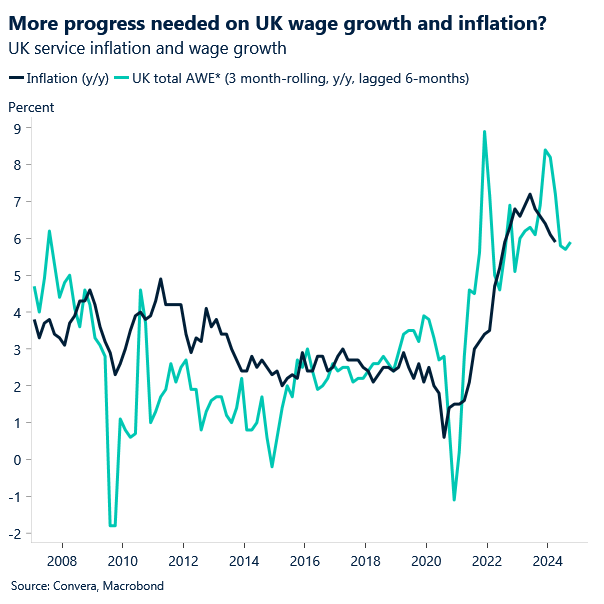Written by Convera’s Market Insights team
Political risk to linger due to French election
Boris Kovacevic – Global Macro Strategist
The unexpected shock wave of the European parliamentary elections is still working its way through financial markets. The attention and lingering effects of the vote have been amplified by the lack of other market moving data at the weekly open on Monday. Rising risk premia as a function of political uncertainty being priced back into European assets has led the French 10-year government bond yield to its highest level so far this year and the euro to a 1-month low. Short-term implied FX volatility rose slightly, incorporating the scheduled snap election in France at the end of the month and option traders turned bearish on the euro at the fastest pace in 14 months. While clearly market moving, it is important to recognize that the election has had more impact on the regional than the European level. This is reflected in the price action. EUR/USD fell more on Friday following the US non-farm payrolls (-0.83%) report than on the election results (-0.58%).
We think that markets did a good job adjusting to the composition of the new European parliament. Now that the initial re-pricing process is over, the medium-term implication for the euro will likely be more muted as the Fed and US macro continue to set the currencies direction. The risk premium due to the upcoming election in France could cap any meaningful gains of the euro. Beyond that, US election risks will start coming into focus, which means that political issues will remain important for markets to keep an eye on. Political uncertainty, the dollar and volatility tend to rise going into a US presidential election. However, US macro will continue to be the primary driver of price action. If the US economy unexpectedly slows beyond what is priced in and the Fed has to cut interest rates sooner than anticipated, European politics will play second fiddle to events unfolding in the US.
Christine Lagarde was the first central banker of significance commenting on monetary policy after the European Central Bank cut interest rates for the first time since 2019 last Thursday. While the easing had been justified by the disinflation seen over the past year or so, rates are not on a linear declining path. She is one of many central bankers who will speak this week. Furthermore, industrial production, Sentix investor sentiment and the trade balance are also due for the Eurozone.

Fed to signal two cuts for 2024
Boris Kovacevic – Global Macro Strategist
Equity markets in Europe suffered losses on Monday but their US peers came into the week fully ignoring the European election results. Both the Nasdaq and S&P 500 pushed higher at the weekly open despite the 2-year Treasury yield recording its biggest daily jump on Friday in two months. Yields are on the rise globally, be it from strong economic momentum (US) or rising political uncertainties (Eurozone). This bodes well for the US dollar, which has followed long-dated Treasuries higher since Friday.
All eyes are now turning to the US CPI and FOMC decision on Wednesday. Economists are expecting a benign inflation report with the headline rate coming in at 0.1% m/m. The annual growth rate would therefore remain unchanged at 3.4% with core inflation expected to fall from 3.6% in April to 3.5% in May. The fall of gasoline and overall energy prices will come as a relief to consumers, but it will hardly convince the Federal Reserve to ease policy over the next 2-3 months.
The benchmark rate will remain unchanged this week and markets have pared back their expectations for the first rate cut from September to December. Given the baseline of a steady policy rate, focus will fall on the press conference and published dot-plot. Fed officials will likely move the median projection to showing two rate cuts for 2024, down from three, keeping the dollar supported.

Sterling steady on mixed jobs report
George Vessey – Lead FX Strategist
While political risk in France has helped GBP/EUR reclaim €1.18, close to 21-month highs, this morning’s UK data dump paints a mixed picture of the UK labour market, somewhat softening the pound. The unemployment rate ticked to a new 2.5-year high from 4.3% to 4.4%, but average weekly earnings rose 6.0% y/y in the three months to April, flat on the figure reported a month ago.
The wage growth measure actually came in slightly lower than the 6.1% forecast, but the measure that includes bonuses rose 5.9% from 5.7%. Moreover, wage growth increased in the public sector (6.3% vs 6.2%) but eased at the private sector (5.8% vs 6.1%). The data did cover the crucial month of April when the minimum wage jumped by almost 10% though, so policymakers at the BoE will welcome the lack of major upticks in wages, which would have added to concerns that a tight labour market is continuing to fuel inflation. Overall, the data shouldn’t do much to sway expectations for the upcoming Bank of England (BoE) monetary policy decision, but the BoE may want more evidence of a cooling jobs market and easing wage growth pressures before signalling a rate cut. CPI data might be more decisive for determining the timing of the first rate cut. If headline inflation gets closer to 2% and services price gains ease further as we expect, the central bank is likely to loosen policy in August, which is our base case once the UK election has concluded in July.
Meanwhile, in line with our own research, Bloomberg’s latest Markets Live Pulse Survey revealed a Labour Party victory in the upcoming UK election would be the best outcome for the British pound. A hung parliament scenario, with no party winning more than half the seats on offer, was seen as the worst result. For now, GBP/USD is trading steady above the $1.27 handle, 3.5% higher than its year-to-date low and less than a cent away from last week’s 2-month high.

GBP/EUR holds firm above €1.18
Table: 7-day currency trends and trading ranges

Key global risk events
Calendar: June 10-14

Have a question? [email protected]
*The FX rates published are provided by Convera’s Market Insights team for research purposes only. The rates have a unique source and may not align to any live exchange rates quoted on other sites. They are not an indication of actual buy/sell rates, or a financial offer.



